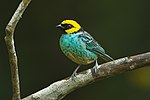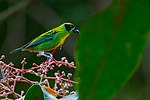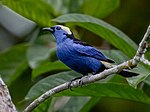Superregnum: Eukaryota
Cladus: Unikonta
Cladus: Opisthokonta
Cladus: Holozoa
Regnum: Animalia
Subregnum: Eumetazoa
Cladus: Bilateria
Cladus: Nephrozoa
Superphylum: Deuterostomia
Phylum: Chordata
Subphylum: Vertebrata
Infraphylum: Gnathostomata
Megaclassis: Osteichthyes
Cladus: Sarcopterygii
Cladus: Rhipidistia
Cladus: Tetrapodomorpha
Cladus: Eotetrapodiformes
Cladus: Elpistostegalia
Superclassis: Tetrapoda
Cladus: Reptiliomorpha
Cladus: Amniota
Classis: Reptilia
Cladus: Eureptilia
Cladus: Romeriida
Subclassis: Diapsida
Cladus: Sauria
Infraclassis: Archosauromorpha
Cladus: Crurotarsi
Divisio: Archosauria
Cladus: Avemetatarsalia
Cladus: Ornithodira
Subtaxon: Dinosauromorpha
Cladus: Dinosauriformes
Cladus: Dracohors
Cladus: Dinosauria
Ordo: Saurischia
Cladus: Eusaurischia
Subordo: Theropoda
Cladus: Neotheropoda
Cladus: Averostra
Cladus: Tetanurae
Cladus: Avetheropoda
Cladus: Coelurosauria
Cladus: Tyrannoraptora
Cladus: Maniraptoromorpha
Cladus: Maniraptoriformes
Cladus: Maniraptora
Cladus: Pennaraptora
Cladus: Paraves
Cladus: Eumaniraptora
Cladus: Avialae
Infraclassis: Aves
Cladus: Euavialae
Cladus: Avebrevicauda
Cladus: Pygostylia
Cladus: Ornithothoraces
Cladus: Ornithuromorpha
Cladus: Carinatae
Parvclassis: Neornithes
Cohors: Neognathae
Cladus: Neoaves
Cladus: Telluraves
Cladus: Australaves
Ordo: Passeriformes
Subordo: Passeri
Infraordo: Passerida
Superfamilia: Passeroidea
Familia: Thraupidae
Genus: Tangara
Species: T. arthus – T. callophrys – T. chilensis – T. chrysotis – T. cyanocephala – T. cyanotis – T. cyanoventris – T. desmaresti – T. dowii – T. fastuosa – T. florida – T. fucosa – T. gyrola – T. icterocephala – T. inornata – T. johannae – T. labradorides – T. lavinia – T. mexicana – T. nigroviridis – T. parzudakii – T. rufigenis – T. schrankii – T. seledon – T. vassorii – T. velia – T. xanthocephala
acc. Burns, Unitt & Mason (2016), IOC 10.2.:
Species transferred to Ixothraupis: T. guttata – T. punctata – T. rufigula – T. varia – T. xanthogastra – acc. SACC 730.19
Species transferred to Chalcothraupis: T. ruficervix – acc. SACC 730.20
Species transferred to Poecilostreptus: T. cabanisi – T. palmeri – acc. SACC 730.20
Species transferred to Stilpnia: T. argyrofenges – T. cayana – T. cucullata – T. cyanicollis – T. cyanoptera – T. heinei – T. larvata – T. meyerdeschauenseei – T. nigrocincta – T. peruviana – T. phillipsi – T. preciosa – T. viridicollis – T. vitriolina – acc. SACC 730.20
Name
Tangara Brisson, 1760
Typus: Aglaia paradisaea Swainson, 1837 = Aglaia chilensis Vigors, 1832 = Tangara chilensis
Synonyms
Calliste F. Boie, 1826 Isis col. 974 BHL
Aglaia Swainson, 1827 Zool.J. p. 347 BHL
Tanagrella Swainson, 1837 Class.Birds p. 286 BHL
Tanagroides Lesson, 1837
Calospiza G.R. Gray, 1840 ListGen.Birds p. 44 BHL
Callospiza (emend.)
Callispiza (emend.)
Procnopis Cabanis, 1844 Arch.Naturgesch. p. 284 BHL
Hypothlypis Cabanis, 1847 Arch.Naturgesch. p. 316 BHL
Gyrola Reichenbach, 1850 Av.Syst.Nat. pl. 77 BHL
Chrysothraupis Bonaparte, 1851 Rev.Mag.Zool. p. 129 BHL
Tatao Bonaparte, 1851 Rev.Mag.Zool. p. 141 BHL
Euprepiste P.L. Sclater, 1851 Contrib.Orn.(Jardine) p. 95 BHL
Euschemon P.L. Sclater, 1851 Contrib.Orn.(Jardine) p. 94 BHL
Diva P.L. Sclater, 1854 TanagrarumCat.Specificus p. 13, 16 BHL
Hemithraupis Ridgway, 1898 Auk p. 226 BHL
Tanara (orth. err.)
References
Primary references
Brisson, M.J. 1760. Ornithologie ou méthode contenant la division des oiseaux en ordres, sections, genres, especes & leurs variétés. A laquelle on a joint une description exacte de chaque espece, avec les citations des auteurs qui en ont traité, les noms qu'ils leur ont donnés, ceux que leur ont donnés les différentes nations, & les noms vulgaires. Ouvrage enrichi de figures en taille-douce. Tome I. - pp. j-xxiv [= 1-24], 1-526, j-lxxiij [= 1-73], Pl. I-XXXVII [= 1-37]. Paris. (Bauche). Original description p. 36 BHL Reference page. Tome 3 p. 3 BHL
Additional references
Burns, K.J., Shultz, A.J., Title, P.O., Mason N.A., Barker, F.K., Klicka, J., Lanyon, S.M. & Lovette, I.J. 2014. Phylogenetics and diversification of tanagers (Passeriformes: Thraupidae), the largest radiation of Neotropical songbirds. Molecular Phylogenetics and Evolution 75:41–77. DOI: 10.1016/j.ympev.2014.02.006 Full article (PDF) Open accessReference page.
Barker, F.K., Burns, K.J., Klicka, J., Lanyon, S.M. & Lovette, I.J. 2015. New insights into New World biogeography: An integrated view from the phylogeny of blackbirds, cardinals, sparrows, tanagers, warblers, and allies. The Auk 132(2): 333-348. DOI: 10.1642/AUK-14-110.1 Open accessReference page.
Burns, K.J., Unitt, P. & Mason, N.A. 2016. A genus-level classification of the family Thraupidae (Class Aves: Order Passeriformes). Zootaxa 4088(3): 329–354. DOI: 10.11646/zootaxa.4088.3.2 Paywall.Reference page.
Tangara is a large genus of birds of the tanager family. It includes 27 species.[1] All are from the Neotropics, and while most are fairly widespread, some have small distributions and are threatened. They are fairly small, ranging in size from 11.5–15 centimetres (4.5–5.9 in). This genus includes some of the most spectacularly colored birds of the world.
Taxonomy and species list
The genus Tangara was introduced by the French zoologist Mathurin Jacques Brisson in 1760 with the paradise tanager (Tangara chilensis) as the type species.[2][3] The name means "dancer" in the extinct Tupi language.[4]
The genus formerly included additional species. A molecular phylogenetic study published in 2014 found that many of the members of Thraupis was embedded within Tangara.[5] In the reorganization to create monophyletic genera, rather than merging Thraupis into Tangara to create an unusually large genus with around 58 species, taxonomists chose to split off species from Tangara into four other genera. Two of these genera were newly erected (Stilpnia, Poecilostreptus) and two were resurrected: they had been introduced earlier but were not in use (Ixothraupis, Chalcothraupis).[6][7]
The genus now contains 27 species:[6]
| Image | Common Name | Scientific name | Distribution |
|---|---|---|---|
 |
Blue-and-black tanager | Tangara vassorii | Bolivia, Colombia, Ecuador, Peru and Venezuela |
 |
Beryl-spangled tanager | Tangara nigroviridis | Colombia through Ecuador and Peru to Bolivia |
.jpg/150px-Tangara_dowii_-Costa_Rica-8_(1).jpg) |
Spangle-cheeked tanager | Tangara dowii | Costa Rica and western Panama |
| Green-naped tanager | Tangara fucosa | Colombia and Panama | |
.jpg/150px-Tangara_cyanotis_-_Blue-browed_Tanager_(cropped).jpg) |
Blue-browed tanager | Tangara cyanotis | Bolivia, Colombia, Ecuador, and Peru |
| Rufous-cheeked tanager | Tangara rufigenis | Venezuela | |
 |
Metallic-green tanager | Tangara labradorides | Colombia, Ecuador, and Peru |
 |
Bay-headed tanager | Tangara gyrola | Ecuador, Bolivia and southern Brazil, and on Trinidad |
 |
Rufous-winged tanager | Tangara lavinia | Colombia, Costa Rica, Ecuador, Honduras, Nicaragua, and Panama |
.jpg/150px-Golden-eared_Tanager_-_Manu_NP_-_Perù_7900_(22954456080).jpg) |
Golden-eared tanager | Tangara chrysotis | eastern Andes of Bolivia, Colombia, Ecuador and Peru |
 |
Saffron-crowned tanager | Tangara xanthocephala | northern Andes of Bolivia, Colombia, Ecuador, Peru, and Venezuela. |
.jpg/150px-Flame-faced_Tanager_(4851596008).jpg) |
Flame-faced tanager | Tangara parzudakii | eastern Andes of Colombia, Ecuador, Peru and Venezuela |
| Blue-whiskered tanager | Tangara johannae | Colombia and Ecuador | |
 |
Green-and-gold tanager | Tangara schrankii | eastern Venezuela, Colombia, Ecuador, Peru, central Bolivia, and northwestern Brazil |
.jpg/150px-Tangara_arthus_-_Tángara_dorada_-_Golden_Tanager_(8542820434).jpg) |
Golden tanager | Tangara arthus | Andes (from Bolivia and northwards) and Venezuelan Coastal Range in north-western South America |
.jpg/150px-Emerald_Tanager_-_San_Luis_-_Costa_Rica_MG_1694_(26584929732).jpg) Costa Rica MG 1694 (26584929732).jpg" decoding="async" srcset="//upload.wikimedia.org/wikipedia/commons/thumb/2/22/Emerald_Tanager_-_San_Luis_-_Costa_Rica_MG_1694_%2826584929732%29.jpg/225px-Emerald_Tanager_-_San_Luis_-_Costa_Rica_MG_1694_%2826584929732%29.jpg 1.5x, //upload.wikimedia.org/wikipedia/commons/thumb/2/22/Emerald_Tanager_-_San_Luis_-_Costa_Rica_MG_1694_%2826584929732%29.jpg/300px-Emerald_Tanager_-_San_Luis_-_Costa_Rica_MG_1694_%2826584929732%29.jpg 2x" data-file-width="1001" data-file-height="760" height="114" width="150" /> Costa Rica MG 1694 (26584929732).jpg" decoding="async" srcset="//upload.wikimedia.org/wikipedia/commons/thumb/2/22/Emerald_Tanager_-_San_Luis_-_Costa_Rica_MG_1694_%2826584929732%29.jpg/225px-Emerald_Tanager_-_San_Luis_-_Costa_Rica_MG_1694_%2826584929732%29.jpg 1.5x, //upload.wikimedia.org/wikipedia/commons/thumb/2/22/Emerald_Tanager_-_San_Luis_-_Costa_Rica_MG_1694_%2826584929732%29.jpg/300px-Emerald_Tanager_-_San_Luis_-_Costa_Rica_MG_1694_%2826584929732%29.jpg 2x" data-file-width="1001" data-file-height="760" height="114" width="150" /> |
Emerald tanager | Tangara florida | Colombia, Costa Rica, Ecuador, and Panama |
.jpg/150px-Silver-throated_Tanager_-_Panama_H8O1974_(22882490849).jpg) |
Silver-throated tanager | Tangara icterocephala | Costa Rica, through Panama and western Colombia, to western Ecuador. |
 |
Seven-colored tanager | Tangara fastuosa | north-eastern Brazil |
 |
Green-headed tanager | Tangara seledon | south-eastern Brazil, far eastern Paraguay, and far north-eastern Argentina |
 |
Red-necked tanager | Tangara cyanocephala | Argentina, Brazil, and Paraguay |
.jpg/150px-Brassy-breasted_Tanager_-_Regua_-_Brazil_S4E1979_(12797187424).jpg) Brazil S4E1979 (12797187424).jpg" decoding="async" srcset="//upload.wikimedia.org/wikipedia/commons/thumb/e/e6/Brassy-breasted_Tanager_-_Regua_-_Brazil_S4E1979_%2812797187424%29.jpg/225px-Brassy-breasted_Tanager_-_Regua_-_Brazil_S4E1979_%2812797187424%29.jpg 1.5x, //upload.wikimedia.org/wikipedia/commons/thumb/e/e6/Brassy-breasted_Tanager_-_Regua_-_Brazil_S4E1979_%2812797187424%29.jpg/300px-Brassy-breasted_Tanager_-_Regua_-_Brazil_S4E1979_%2812797187424%29.jpg 2x" data-file-width="1024" data-file-height="683" height="100" width="150" /> Brazil S4E1979 (12797187424).jpg" decoding="async" srcset="//upload.wikimedia.org/wikipedia/commons/thumb/e/e6/Brassy-breasted_Tanager_-_Regua_-_Brazil_S4E1979_%2812797187424%29.jpg/225px-Brassy-breasted_Tanager_-_Regua_-_Brazil_S4E1979_%2812797187424%29.jpg 1.5x, //upload.wikimedia.org/wikipedia/commons/thumb/e/e6/Brassy-breasted_Tanager_-_Regua_-_Brazil_S4E1979_%2812797187424%29.jpg/300px-Brassy-breasted_Tanager_-_Regua_-_Brazil_S4E1979_%2812797187424%29.jpg 2x" data-file-width="1024" data-file-height="683" height="100" width="150" /> |
Brassy-breasted tanager | Tangara desmaresti | Brazil |
 |
Gilt-edged tanager | Tangara cyanoventris | Brazil |
.jpg/150px-Tangara_inornata_by_Brian_Gratwicke_(cropped).jpg) |
Plain-colored tanager | Tangara inornata | Colombia, Costa Rica, and Panama |
 |
Turquoise tanager | Tangara mexicana | Trinidad, Colombia and Venezuela south to Bolivia and much of Brazil |
 |
Paradise tanager | Tangara chilensis | western and northern Amazon Basin in South America, it occurs in Venezuela, Peru, Colombia, Ecuador, Bolivia, Brazil and the Guianas |
 Brazil.jpg" decoding="async" srcset="//upload.wikimedia.org/wikipedia/commons/thumb/6/68/Tangara_callophrys_-_Opal-crowned_Tanager%3B_Serra_do_Divisor_National_Park%2C_Acre%2C_Brazil.jpg/225px-Tangara_callophrys_-_Opal-crowned_Tanager%3B_Serra_do_Divisor_National_Park%2C_Acre%2C_Brazil.jpg 1.5x, //upload.wikimedia.org/wikipedia/commons/thumb/6/68/Tangara_callophrys_-_Opal-crowned_Tanager%3B_Serra_do_Divisor_National_Park%2C_Acre%2C_Brazil.jpg/300px-Tangara_callophrys_-_Opal-crowned_Tanager%3B_Serra_do_Divisor_National_Park%2C_Acre%2C_Brazil.jpg 2x" data-file-width="2071" data-file-height="1553" height="112" width="150" /> Brazil.jpg" decoding="async" srcset="//upload.wikimedia.org/wikipedia/commons/thumb/6/68/Tangara_callophrys_-_Opal-crowned_Tanager%3B_Serra_do_Divisor_National_Park%2C_Acre%2C_Brazil.jpg/225px-Tangara_callophrys_-_Opal-crowned_Tanager%3B_Serra_do_Divisor_National_Park%2C_Acre%2C_Brazil.jpg 1.5x, //upload.wikimedia.org/wikipedia/commons/thumb/6/68/Tangara_callophrys_-_Opal-crowned_Tanager%3B_Serra_do_Divisor_National_Park%2C_Acre%2C_Brazil.jpg/300px-Tangara_callophrys_-_Opal-crowned_Tanager%3B_Serra_do_Divisor_National_Park%2C_Acre%2C_Brazil.jpg 2x" data-file-width="2071" data-file-height="1553" height="112" width="150" /> |
Opal-crowned tanager | Tangara callophrys | southern Colombia, eastern Ecuador and Peru and a region of northwestern Bolivia; for Brazil |
.jpg/150px-Tangara_velia_Opal-rumped_Tanager_(cropped).jpg) |
Opal-rumped tanager | Tangara velia | Amazon and Atlantic Forest of South America |
Distribution and habitat
These tanagers are mainly found high in forest canopies, but some occupy more open habitat. They are found at all elevations below tree line but are most diverse in the Andean subtropical and foothill forests of Colombia, Ecuador and Peru.
Behaviour and ecology
Breeding
The female builds a usually well concealed cup nest and lays two brown- or lilac-speckled white eggs. These hatch in 13–14 days and the chicks fledge in a further 15–16 days. The male and female feed the nestlings on insects and fruit, and may be assisted by helpers.
Food and feeding
Tangara tanagers pick insects from leaves, or sometimes in flight, but fruit is a major dietary item, accounting for 53-86% of food items in those species which have been studied.
References
Sedano, R.E.; Burns, K.J. (2010). "Are the Northern Andes a species pump for Neotropical birds? Phylogenetics and biogeography of a clade of Neotropical tanagers (Aves: Thraupini)". Journal of Biogeography. 37: 325–343. doi:10.1111/j.1365-2699.2009.02200.x.
Brisson, Mathurin Jacques (1760). Ornithologie, ou, Méthode Contenant la Division des Oiseaux en Ordres, Sections, Genres, Especes & leurs Variétés (in French and Latin). Paris: Jean-Baptiste Bauche. Vol. 1 p. 36 and Vol. 3 p. 3.
Paynter, Raymond A. Jr, ed. (1970). Check-list of Birds of the World. Vol. 13. Cambridge, Massachusetts: Museum of Comparative Zoology. p. 359.
Jobling, J.A. (2018). del Hoyo, J.; Elliott, A.; Sargatal, J.; Christie, D.A.; de Juana, E. (eds.). "Key to Scientific Names in Ornithology". Handbook of the Birds of the World Alive. Lynx Edicions. Retrieved 2 April 2018.
Burns, K.J.; Shultz, A.J.; Title, P.O.; Mason, N.A.; Barker, F.K.; Klicka, J.; Lanyon, S.M.; Lovette, I.J. (2014). "Phylogenetics and diversification of tanagers (Passeriformes: Thraupidae), the largest radiation of Neotropical songbirds". Molecular Phylogenetics and Evolution. 75: 41–77. doi:10.1016/j.ympev.2014.02.006.
Gill, Frank; Donsker, David; Rasmussen, Pamela, eds. (July 2020). "Tanagers and allies". IOC World Bird List Version 10.2. International Ornithologists' Union. Retrieved 19 October 2020.
Burns, K.J.; Unitt, P.; Mason, N.A. (2016). "A genus-level classification of the family Thraupidae (Class Aves: Order Passeriformes)". Zootaxa. 4088 (3): 329–354. doi:10.11646/zootaxa.4088.3.2.
Further reading
ffrench, Richard (1991). A Guide to the Birds of Trinidad and Tobago (2nd ed.). Comstock Publishing. ISBN 0-8014-9792-2..
Hilty, Steven L (2003). Birds of Venezuela. London: Christopher Helm. ISBN 0-7136-6418-5..
Morton, Isler & Isler, Tanagers ISBN 0-7136-5116-4.
Stiles and Skutch, A guide to the birds of Costa Rica ISBN 0-8014-9600-4.
Retrieved from "http://en.wikipedia.org/"
All text is available under the terms of the GNU Free Documentation License

